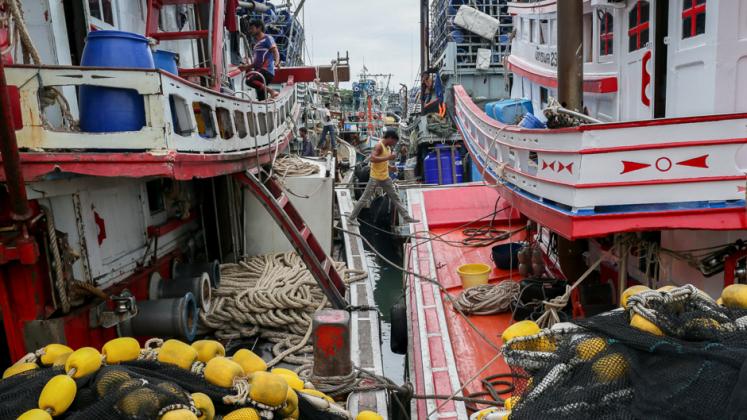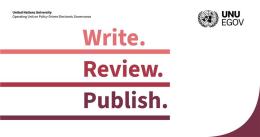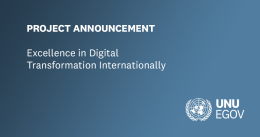Twenty years ago, the United Nations General Assembly adopted the Palermo Protocols as part of a new UN arm working to stop transnational and organised crime, the UN Convention against Transnational Organized Crime (UNTOC). But since 2000, a new breed of technology tools has emerged to work across borders, cultures, governments, and languages with the goal of keeping people safe. Into 2021 and beyond, governments and companies alike can use frontier technologies – including expert systems and blockchain transactions – as tools for enforcing the Palermo Protocols. Moving forward, integrating leaps in technology into the existing multilateral initiatives, local legal policies, and social movements against human trafficking will be the most effective way to address the problem at scale.
Context: Why Create the Protocols?
Before the year 2000, no international legislation existed to regulate human trafficking. After the fall of the Soviet Union, the 1990s brought the reshaping of countries and societies, making the world ripe for criminals to exploit newly open societies and markets. According to a recent interview with Marjan Wijers — a researcher on human trafficking who was in the room when the Palermo Protocols were negotiated this increased interest was partially because victims of trafficking changed from women of color to white women, as Eastern Europeans became the targets of trafficking in Russia. She also argues it was because human trafficking began to serve urgent state interests after the fall of the Berlin Wall. Further, bilateral attempts between the Italian and US governments to stop mob activity in both countries captured media attention across the decade with sagas of theft, corruption, and graft.
In short, as global societies embraced new forms of political and social diversity and progress, transnational policies were needed to quell a growing group of organised criminals. One of the three legal protocols includes the Protocol to Prevent, Suppress and Punish Trafficking in Persons, especially Women and Children. This protocol was revolutionary in that it identified a systemic global problem: human trafficking.
It is never easy to reach a consensus across 190 nations, and for that reason alone the Protocol was an exceptional feat of international legislation. But before taking stock of where they stand now, we must consider their origins. In 2000, Palermo, Sicily was chosen as the site of such an historic document in part because it was the home of anti-mafia prosecutor Giovanni Falcone, who was also assassinated there by organised criminals in May 1992. He and other Italian, American, and Western legal brains are credited with crafting the legal arguments of the document. Further, the UNTOC itself was formed on the back of the Cold War during a period in international affairs when a multilateral diplomatic process that excluded Asia had just been used as a strategy for remediating a complicated geopolitical problem.
Historically, the trafficking protocol was hailed as a victory for the global women’s rights movement. Woven into Section 4, Article 9 of the Protocol to Prevent, Suppress and Punish Trafficking in Persons is a stipulation that all signatories to the trafficking protocol must work towards the social advancement of women. Perhaps it was the heated debate over two years leading up to the document’s ratification that eventually made sex trafficking the focus of an entire protocol. The Human Rights Caucus of the U.S. Senate had argued that sex work is legitimate if consensual, while the Coalition Against Trafficking in Women (CATW) saw any form of prostitution as human trafficking. Eventually, the Protocols signed with the former, criminalising sex work only if the work is forced.
20 Years On: Contemporary Critiques of the Protocols
Since their global adoption, significant critiques of the Protocols have emerged that demand further consideration. From its design, the trafficking protocol in particular treats the symptoms of human trafficking after it has already happened, rather than offer a legal framework for approaches to combatting its root causes. That protocol also places an unfair burden on “destination” countries to regulate human trafficking, failing to require either destination or country of origin states to implement measures preventing human trafficking or protecting its victims. Further, it does not consider how factors beyond gender, such as race and LGBQI identification, increase an individual’s vulnerability to trafficking, or how working conditions may begin as safe but can evolve into exploitative situations over time.
Broad wording across the trafficking protocol have led to debates surrounding definitions of phrases such as “human trafficking” and “forced labor”. The former is defined domestically by the US Department of Homeland Security as “the use of force, fraud, or coercion to obtain some type of labor or commercial sex act”. In contrast, the phrase “forced labor” under the International Labor Organization (ILO) definition refers to “work that is performed involuntarily and under the menace of any penalty". While the definitions overlap, intersect, and at times used interchangeably, the term human trafficking will be used here as it is critical to the wording of the trafficking protocol.
An enduring critique of the trafficking protocol is its enshrinement of human trafficking as a criminal – rather than human or labor rights – violation. Criminalising human trafficking turns victims into defendants. It makes positive remediation a matter of winning court cases rather than examining the systemic issues, including social inequality, poverty, racism, sexism, and other forms of discrimination, that perpetuate human trafficking. Lawyers shy away from taking human trafficking cases because evidence can be difficult to procure given the stark power imbalance between the defendant — a victim of human trafficking — and the entity that perpetuated harmful practices. Even when individual cases make it across a lawyer’s desk or even as far as a court system, the probability of positive individual remediation remains woefully low. But if successful legal case results can be aggregated and tracked, post-hoc legal analyses could be publicised giving multilateral organisations, governments, companies, and human and labor rights organisations a better understanding of the ecosystem perpetuating forced labor. Working within a criminal definition of human trafficking, aggregating individual information from victims has the potential to improve the chances of positive remediation for defendants. Until now, aggregating the information of trafficked individuals has been impossible. But new technologies such as expert systems and blockchain may make such aggregation possible.
A Case for Frontier Technology to Combat Forced Labor: Expert Systems and Blockchain
The nuanced problem of forced labor demands solutions that intersect across the issue’s entire life cycle, including worker recruitment, exploitation identification, and case remediation. A new suite of tools, known as frontier technologies, has the potential to increase transparency throughout each of the aforementioned phases.
This buzzword is often used to describe a wide range of technologies, including cloud computing, artificial intelligence (AI), and the Internet of Things (IoT). Frontier technologies are sometimes naively framed as one-stop-shop solutions to intricate problems. But they alone will not ensure that the trafficking protocol protects victims of forced labor into the next decade. Rather, these tools can provide strong support to sound multilateral institutions, dedicated international lawyers, and advocacy shifts encouraging the global movement to end human trafficking. Two forms of frontier technology are already being used to combat human trafficking on small but scalable projects: Expert systems and blockchain.
Expert systems use AI to support the decision-making abilities of non-experts. Built on a knowledge base of expertise contributed by domain experts, these systems support non-experts making an informed decision about a particular problem. Worker voice tools such as Apprise are built on expert systems that have emerged to identify instances of human trafficking. Apprise was built as a screening tool to help front-line responders identify cases of exploitative work across a spectrum; ranging from decent work on one end to forced labor on another. These tools offer a pathway for workers to confidentially elevate their concerns to frontline responders. Because of the expert system backend, when a frontline responder uses tools like Apprise to interview a worker, the tool can map a worker’s circumstances onto the ILO indicators of human trafficking and shares a detailed vulnerability calculation. This provides a frontline responder with information to inform their next steps.
A concrete first step for the implementation of Apprise could be its systematic uptake by frontline responders. Immigration officers, police officers, NGO outreach teams, or labor inspectors can privately collect and confidentially share details of exploitation patterns from victims. Subsequently, this aggregate interview data from Apprise, collected over time and across contexts, allows a fuller picture of exploitation. Through a process known in public health as sentinel surveillance, aggregated data from Apprise can be used to identify geographic or sector specific “hot spots” of exploitation and allow observers to understand macro-level changing practices of exploitation. Apprise therefore gives governments, multilateral institutions, companies, and NGOs a system-level perspective on the problem of human trafficking, rather than a disparate, case-by-case analysis. This big-data perspective on what is happening in real time empowers actors to implement nuanced policy changes towards eradicating human trafficking.
While blockchain was originally designed for financial transactions, stakeholders are exploring the application of blockchain’s distributed ledger system to other contexts. At its core, blockchain acts as a public ledger shared across a network of participants, who can both validate transactions and keep a copy of the ledger itself. Along a blockchain, specific consensus protocols allow individuals to decide who can validate a transaction. They can also create semi-private blockchains, where a limited set of actors see the blockchain’s information. Only select actors can add and verify content. eMin is an example of the use of blockchain for secure worker documentation collection, overcoming issues with missing contracts, or contract substitution in supply chains. This system allows factories to verify that their workers are recruited to work for a living wage, and everyone from workers, to government officials, to corporate executives can see when and how workers are paid.
Workers could use semi-private or private blockchains to track contract modifications. However, data-privacy concerns could prevent individuals from uploading their information, even onto this this type of data repository. It is important to note that this ledger would only reflect accurate information if all actors from workers to factory owners have the power and technological skills to modify the chain. Without sufficient consideration of workers’ technology access or literacy, blockchain solutions may exclude the voices of exploited individuals. In its worst form, this could further marginalise the individuals that it is designed to support. Further, malevolent actors could enter a semi-private blockchain and validate each other’s false claims, perpetuating and validating organised crime.
Though still in early development, there is great potential for blockchain-related systems to intervene in the early stages of human trafficking, particularly during the recruitment phase. A first step would be integrating existing successful tools such as eMin into multiple corporations’ CSR strategies, thereby disrupting the status quo of exploitative recruitment processes.
Often described as an amplifier of intent, technology magnifies the intentions of its users and developers alike. As a double-edged sword, technology is often falsely heralded as a pathway to provide quick-fix solutions to complex problems. But technology, like any other tool, can be used to impede or facilitate exploitation, fraud, or deception, depending on the intentions of the actors involved. While in the above two examples, expert systems and blockchain tools can be used to support the fight against human trafficking, they can also be used to perpetuate human trafficking. Criminals already use permutations of frontier technologies, including other AI systems, to carry out business email compromise, facilitate identity theft or initiate phishing attacks. Further, the loosely defined phrase ‘cybertrafficking’ has also been used to describe how traffickers identify and recruit victims of trafficking online and control their victims once trafficked.
Unlike twenty years ago when the trafficking protocol was first written, big data approaches have emerged to provide a macro-level perspective of potentially trafficked individuals. This gives us the freedom to gather information about how and why people are trafficked and exploited. Numerous corporate case studies show that aggregating more and better employment and payment data while protecting individual workers’ privacy can lead to better solutions for complex problems. Big data approaches can therefore expose where the root causes of human trafficking lie.
But we are still a long way from making the dreams of better tech when it comes to the trafficking protocol a reality. Rudimentary technology concerns, such as a lack of internet access or availability of technology tools in their native languages, may prevent government actors, companies and everyday citizens from accessing the tools necessary to enforce the protocol.
But after twenty years and millions of dollars spent annually to combat human trafficking across the world, governments, technologists, and corporations have barely scratched the surface of the problem. Frontier technologies can combat the roots of human trafficking through identifying its hotspots, patterns, and factors that exacerbate vulnerabilities beyond gender. Mapping these patterns out on a large-scale over time gives global multilateral institutions and governments sufficient data to craft preventative solutions, with potential to reduce the burden on “destination” countries to regulate human trafficking. While certainly not a one-stop solution, as we enter a new decade in the fight to end human trafficking, frontier technology will play an integral role. Going forward, the role it plays must be better informed than a litany of scattered previous efforts.
Further Reading
For more detailed analysis, a special issue of the Journal of Human Trafficking released on March 28, 2020 looks at several contemporary analyses of the Palermo Protocols’ impact into 2020. This series for Open Democracy funded through Humanity United critically engages with the protocols and examines two questions for debates surrounding the protocols’ validity: “What is exploitation?” and “Are we better off on the inside?”. In addition, this October 2020 report from the Global Initiative Against Transnational and Organized Crime reviews the Protocols’ progress and setbacks over the past 20 years in an historical context.
•••
This article was first published in the Spring 2021 issue (Vol. 16, No. 1) of the Yale Journal of International Affairs, a graduate student-run journal associated with the Yale Jackson Institute for Global Affairs. Views expressed in this piece are the authors', and do not necessarily represent those of the editorial board, board of advisers, MacMillan Center, Jackson Institute, or any other entity at Yale University.
Suggested citation: Sophie Zinser, Hannah Thinyane. "A Step Forward for Palermo’s Trafficking Protocol, This Time Integrating Frontier Technology," United Nations University, UNU Centre, UNU Macau, 2021-10-04, https://unu.edu/article/step-forward-palermos-trafficking-protocol-time-integrating-frontier-technology.






